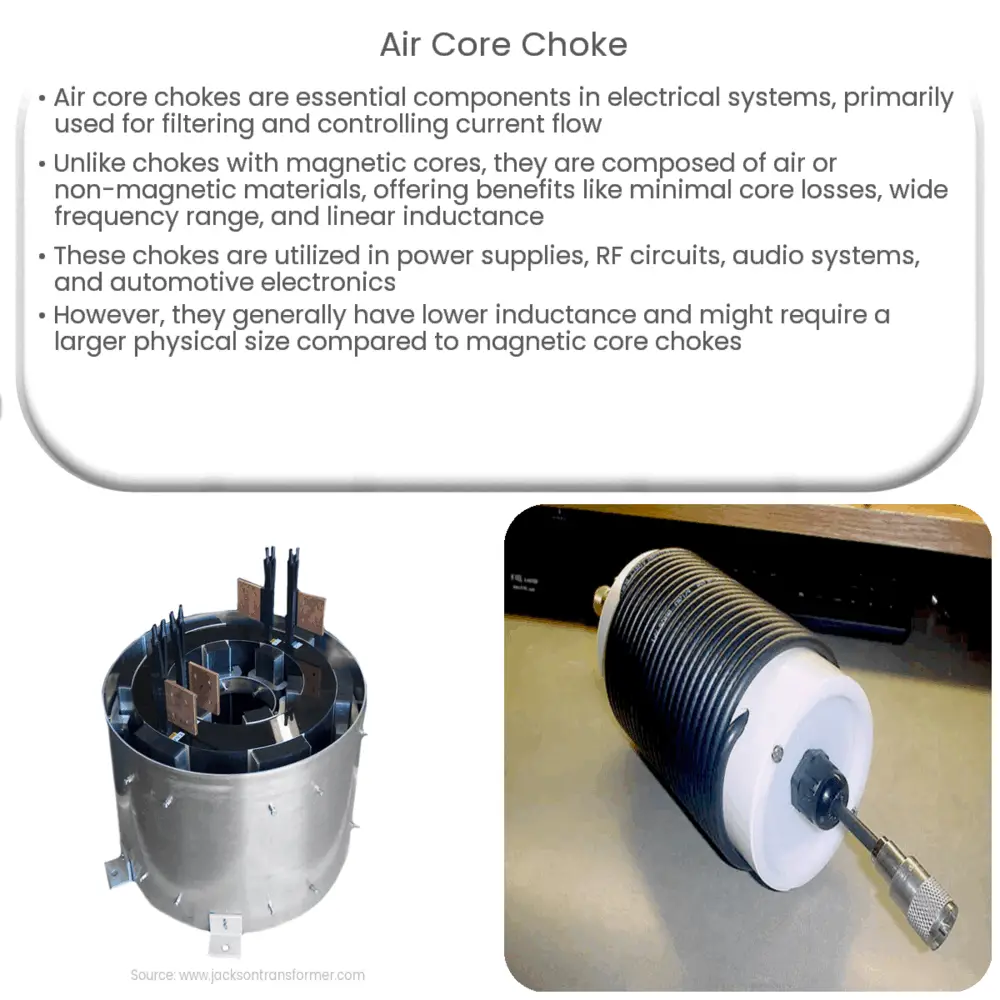Air core chokes are inductors with non-magnetic cores, offering minimal core losses, wide frequency range, and reduced EMI for various applications.

Air Core Choke: Principles, Applications, and Advantages
Introduction
The air core choke is an essential component in various electrical and electronic systems. It is a type of inductor that is primarily used for filtering and controlling current flow in circuits. This article will discuss the principles of air core chokes, their applications, and the advantages they offer compared to other types of chokes.
Principles of Air Core Chokes
Air core chokes are a specific type of inductor that does not use a magnetic core made from ferromagnetic materials such as iron or ferrite. Instead, as the name suggests, the core is composed of air or another non-magnetic material, and the inductor is wound around this core. The absence of a magnetic core results in a number of characteristics that distinguish air core chokes from their counterparts.
When a current passes through the coil of the air core choke, it generates a magnetic field. This magnetic field, in turn, induces a voltage across the coil. The relationship between the current, magnetic field, and induced voltage is described by Faraday’s Law of Electromagnetic Induction. The inductance, which is the ability of the coil to store energy in its magnetic field, depends on factors such as the number of turns in the coil, the coil’s diameter, and the length of the coil.
Applications of Air Core Chokes
Air core chokes are used in a wide range of applications, including:
- Power Supplies: In switched-mode power supplies (SMPS), air core chokes help to filter high-frequency noise and stabilize the output voltage by limiting the rate of change in the current.
- Radio Frequency (RF) Circuits: Due to their excellent high-frequency performance, air core chokes are used in RF circuits for impedance matching, filtering, and isolation purposes.
- Audio Systems: Air core chokes are employed in audio systems to minimize distortion and maintain signal quality by filtering out high-frequency noise and preventing electromagnetic interference (EMI).
- Automotive Electronics: In the automotive industry, air core chokes are used to filter noise and reduce EMI in various electronic systems such as engine control modules, transmission control modules, and infotainment systems.
Advantages of Air Core Chokes
Compared to other types of chokes, air core chokes offer several advantages:
- Low Core Losses: Since air core chokes do not have a magnetic core, they exhibit minimal core losses, which results in higher efficiency and reduced heating.
- Wide Frequency Range: Air core chokes can operate effectively over a broad range of frequencies, making them suitable for high-frequency applications such as RF and SMPS circuits.
- Linear Inductance: The inductance of an air core choke remains constant over a wide range of currents, providing more predictable and stable performance in the circuit.
Minimal Saturation
4. Minimal Saturation: Unlike chokes with magnetic cores, air core chokes do not saturate under high currents. Saturation occurs when the magnetic core material cannot support any additional increase in the magnetic field, resulting in a reduction of inductance. Since air core chokes do not have a magnetic core, they are less susceptible to saturation, maintaining their inductance and performance under high current conditions.
Reduced EMI and Noise
5. Reduced EMI and Noise: Air core chokes exhibit lower electromagnetic interference (EMI) and noise levels compared to chokes with magnetic cores. This is because air core chokes do not have a magnetic core that can generate additional EMI or interact with external magnetic fields, making them ideal for use in sensitive electronic circuits and systems.
Lightweight and Compact
6. Lightweight and Compact: Air core chokes are typically lighter and more compact than their counterparts with magnetic cores. This makes them well-suited for applications where weight and size constraints are critical, such as in aerospace and automotive electronics.
Limitations of Air Core Chokes
Despite their advantages, air core chokes also have some limitations:
- Lower Inductance: Air core chokes generally have lower inductance values compared to chokes with magnetic cores, which may limit their suitability in applications requiring high inductance.
- Physical Size: To achieve higher inductance values, air core chokes often require more turns of wire and larger coil dimensions, resulting in a larger physical size compared to chokes with magnetic cores.
Conclusion
Air core chokes are a valuable component in a wide range of electrical and electronic systems, offering a host of advantages over chokes with magnetic cores. Their minimal core losses, wide frequency range, linear inductance, reduced EMI and noise, and lightweight and compact design make them suitable for numerous applications, including power supplies, RF circuits, audio systems, and automotive electronics. However, their lower inductance and potentially larger physical size should also be taken into account when selecting the appropriate choke for a specific application. By understanding the principles, applications, and advantages of air core chokes, engineers and designers can make informed decisions when incorporating them into their designs.

